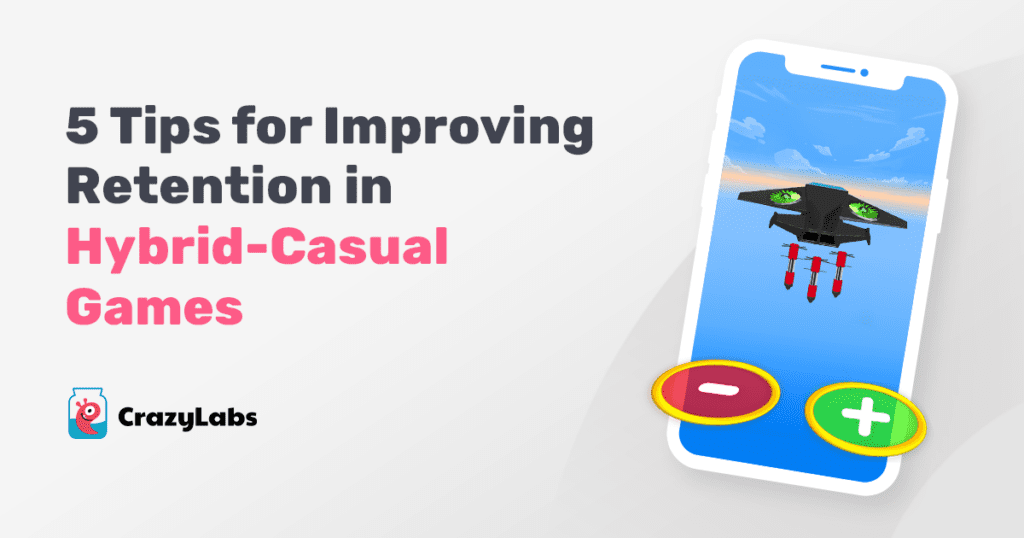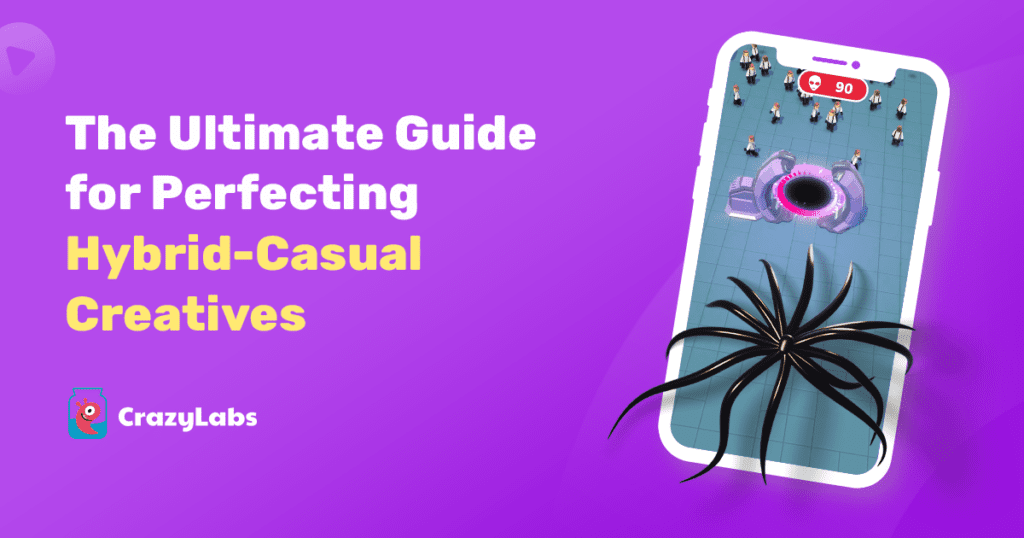Mobile game design holds immense significance in both hyper-casual and hybrid-casual games as it directly influences player engagement, retention, monetization, and overall game success. Below, we present our top recommendations for achieving outstanding mobile game design in both hyper-casual and hybrid-casual genres, as shared by CrazyLabs’ Lead Game Designers.
Mobile Game Design Winning Tips
The Basics:
- Embrace Simplicity: Hyper-casual and hybrid-casual games thrive on simplicity. The controls should be so intuitive that players can jump right into the action without a tutorial. Minimize text instructions and focus on visual cues and gestures like tapping, swiping, or dragging. Remember, simplicity doesn’t mean sacrificing depth; it means making complex concepts accessible.
- Instant Engagement: Hook your players within the first few seconds. Create an engaging introduction that showcases the core mechanics or the excitement of the game. Players should feel compelled to keep playing after just a few taps.
- Visual Appeal: Invest in a clean, minimalist visual style. Use bright, appealing colors and create easily distinguishable elements. A consistent visual theme throughout the game helps players instantly recognize your brand.
Pro tip: Hybrid-casual and hyper-casual players are sometimes discouraged by games that appear overly polished. They may perceive highly polished games as potentially demanding more commitment than they’re comfortable with. When a game looks too much like a traditional “real game” rather than something “simple,” some players might feel it’s too challenging for them.
- Short Sessions: Both Hyper-casual and hybrid-casual games are often played in short, casual bursts. Design levels or gameplay sessions that can be completed in a matter of minutes or even seconds. This encourages players to keep coming back for more.
Embrace Progression Clarity
Progress is a fundamental UI element and is the key to your player feeling a sense of momentum through your game. The constant desire to reach an objective or destination will keep your players engaged and increase your session length and retention.
This is why it’s important to inform players in advance that exciting rewards await them as they progress. This provides them with mid and long-term objectives, motivating them to continue playing – at least until they achieve the initial milestone you’ve presented. Ensure that they receive a rewarding experience upon reaching this milestone, enticing them to aim for the next one. Below are examples of progression clarity in CrazyLabs’ games:
In Evolving Bombs, you can see the strong ‘level progress’ bar at the top of the ‘start’ screen. The player can clearly see their current level and their progression through the ‘sub-levels’ in order to reach the mysterious ‘end goal’ (marked with a tantalizing skull).
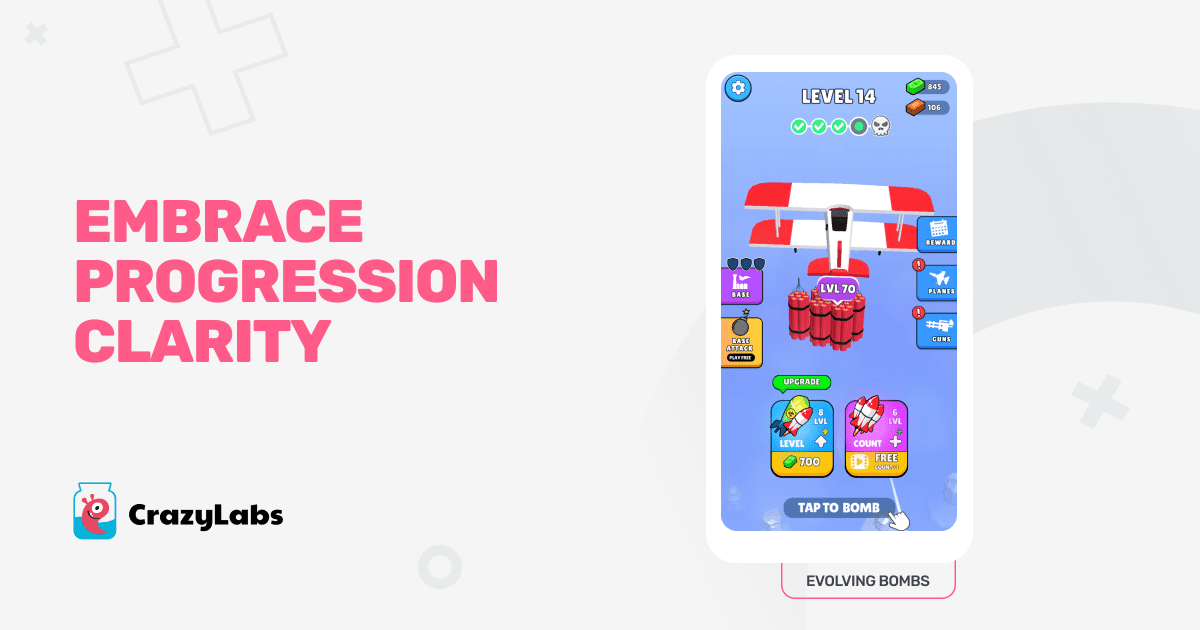
Multi-layered Progression Systems
Now that we have strong visualization of our players’ progress, we must decide exactly what they are progressing toward. A single ‘progression system’ is not enough to give the player a constant sense of direction and achievement. By providing short, medium and long-term goals (progression systems), we may broadly appeal to a range of players.
The game Alien Invasion: RPG Idle Space exemplifies the concept of ‘progression.’ As a fusion of the idle-arcade and RPG genres, it is predominantly centered around a multitude of progression metrics and player upgrades. Players advance through a linear sequence of levels (following standard level progression) by earning experience (XP). However, to do this efficiently, they have a vast array of upgrades available (constituting player attribute progression). Since players can freely choose which attributes to upgrade at any given time, they are presented with a continuous, impactful, and seemingly never-ending array of progression mechanics to pursue. The inclusion of quests (offering narrative progression) further solidifies this game as truly centered on progression.
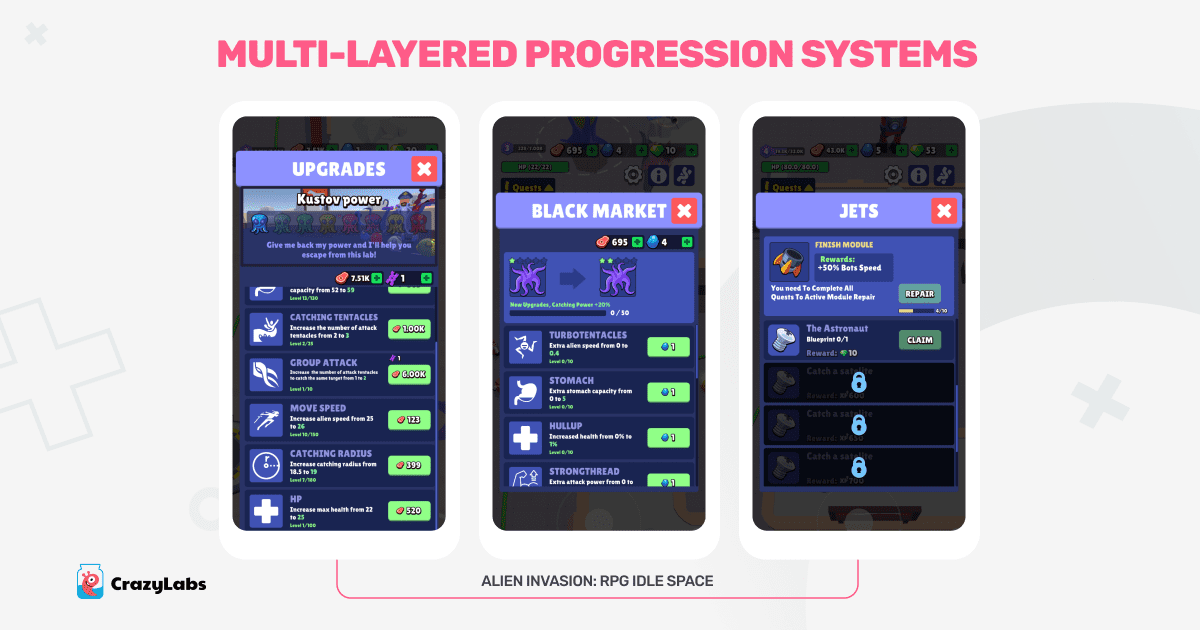
Missions, achievements and/or collections may be considered secondary goals – given to the player in order to provide optional structure to the game. These can be powerful mechanics as they can sit silently atop the core game, providing motivation for the player to engage with the game in a different way than they usually would. Below are examples of how we implement this in our games:
AMAZE implements the classic ‘achievement’ system, a powerful motivator for the ‘completionist’ subset of players. It may guide the player toward different game modes, longer sessions or other behaviors that keep the game feeling ‘fresh’ and by extension, increase playtime.
Mystical Mixing allows the player to magically create creatures from a range of ingredients. These combinations are colorful, exciting, and most of all, numerous. To guide the player and encourage them to explore all of the possibilities of mystically-mixing, the game offers a ‘Collection’, in which the player may see the creatures they have created, but more importantly – the creatures they have not created. This inspires the perfectionist subset of players to engage for longer and to more fully explore the game.
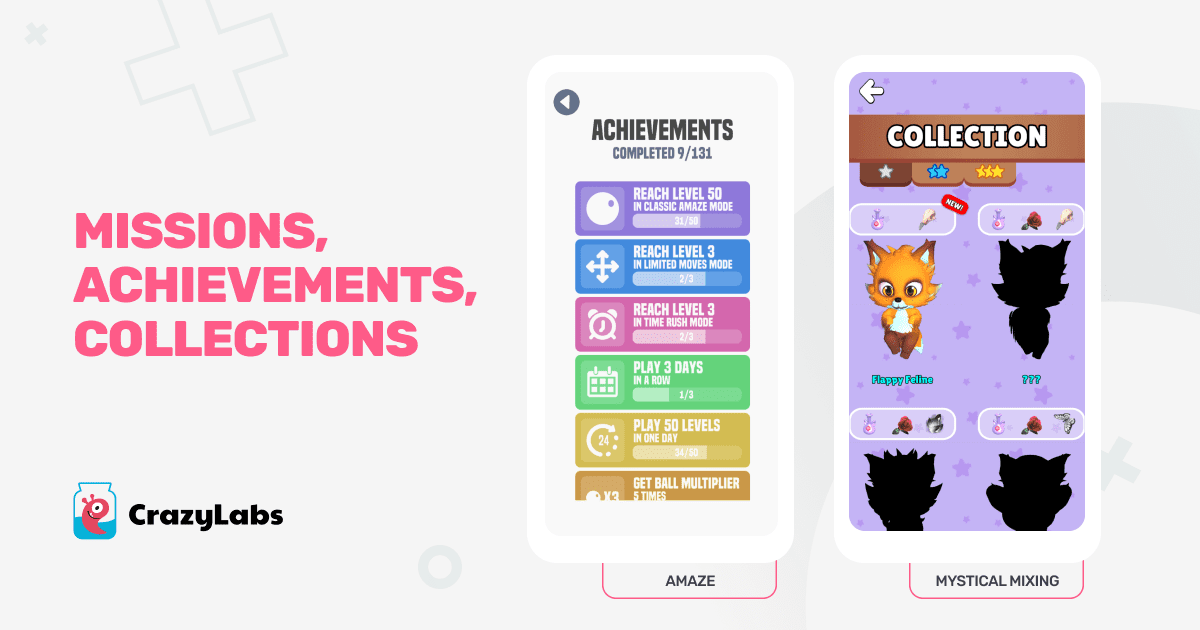
Experiment with Tension
The aspects of ‘difficulty’ or ‘tension’ are often overlooked in hyper-casual and hybrid-casual games, and they depend heavily on the market and the game’s genre. However, it can be a powerful motivator for a subset of players who wish to showcase their skills or challenge their brains. By adding an element of either mechanical skill (reflexes) or functional skill (abilities granted by the game logic itself), the player may be driven to play more, to replay, and ultimately to consume RVs or IAPs in order to triumph.
In CrazyLabs’s AMAZE game, it implements a ‘soft’ form of difficulty allowing the player to choose if they wish to have a more ‘zen’, relaxing experience, or challenge their brain by attempting to complete levels within a limited number of moves. Note that this is supported by two RV options (‘hint’ and ‘multiball’), gently monetizing the player’s desire for further challenge.
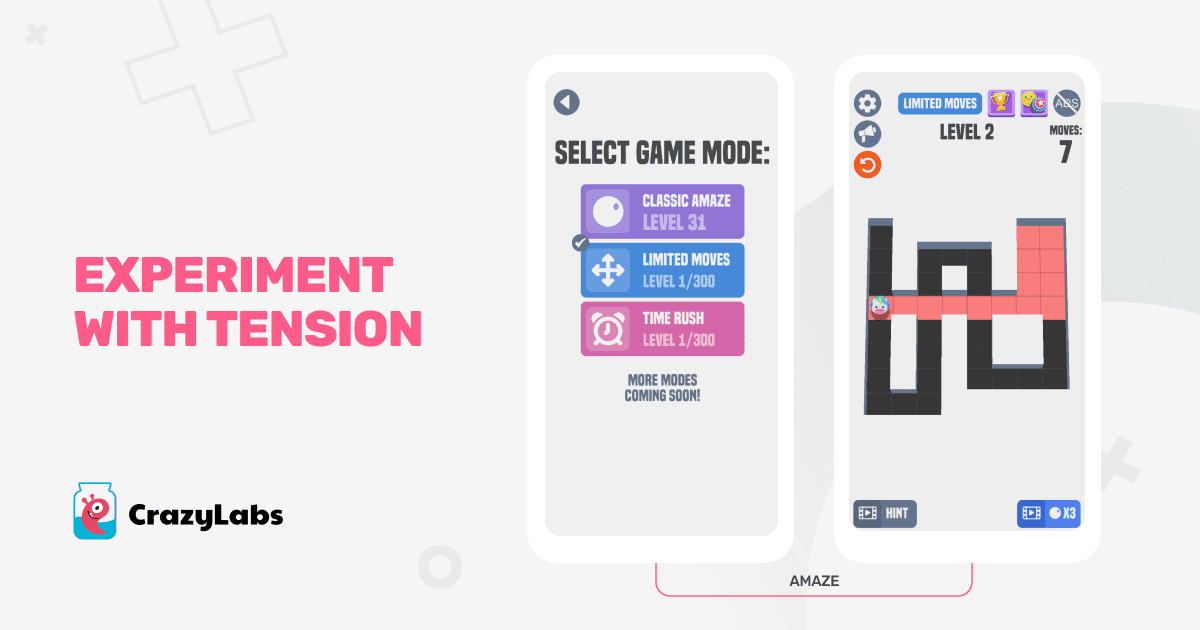
In the game Alien Invasion: RPG Idle Space, players will encounter a ‘satellite’ enemy during the early stages of gameplay. This enemy will swiftly move away from the player, gradually increasing its speed, enticing the player to chase it until it is ultimately ‘consumed’. This design feature adds a delightful (albeit tense!) element to the game, as it requires players to combine their physical gaming skills with in-game upgrades to become fast enough to catch and defeat the enemy, thereby completing the quest. Players may need to make multiple attempts, practice their control skills, and continuously enhance their ‘movement speed’ and ‘catching speed’ attributes to overcome this formidable adversary.
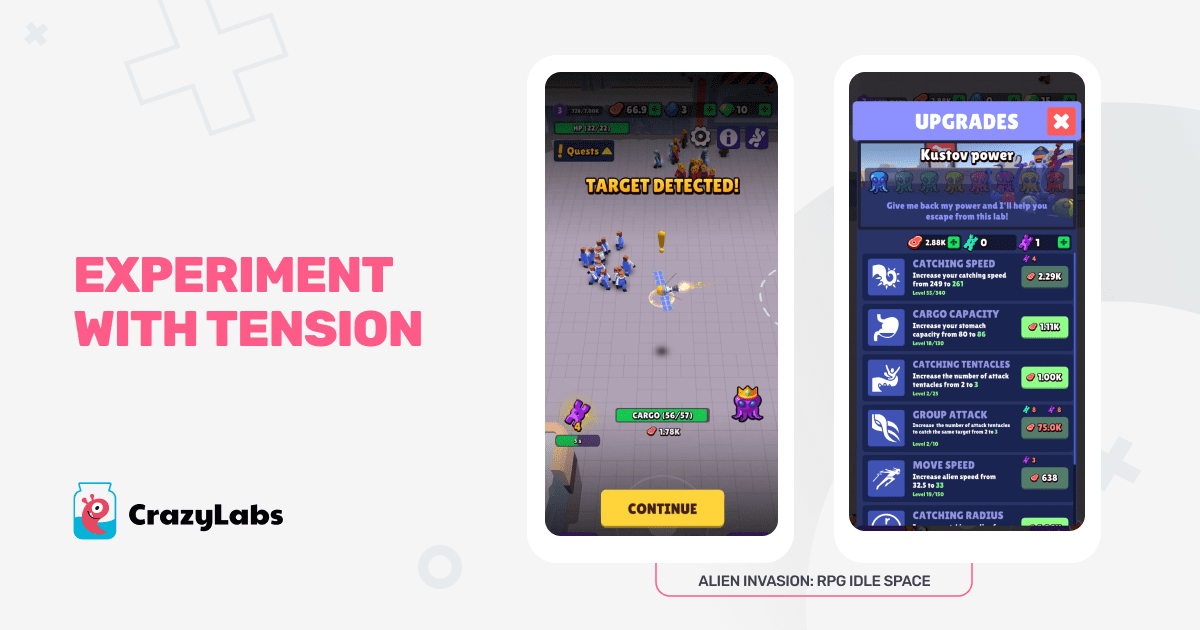
A Well-Integrated (and Meaningful!) Meta Layer
Your core game is solid, your players are enjoying it and you have some excellent and highly-visible progression systems. Great! But what is the player playing toward? What tangible, gameplay-driven goal will give them the passion (and addiction) to push through Day 7 all the way to Day 30?
A well-integrated meta layer is a powerful layer to add atop your existing core game. The most crucial aspect of this is that the core game must feed the meta layer, and in turn, the meta layer must feed back into the core game.
In Evolving Bombs, as the player boldly bombs their targets within the core of the game, they earn a secondary currency, ‘bricks’. With these bricks, they may then construct their own ‘base’ within the metagame. By continually playing the core game, earning bricks, and constructing their ‘base’, the player will earn multipliers that increase their earnings in the core game. Thus, the cycle comes full circle, from the core game to the metagame and, ultimately, back to the core game once more.
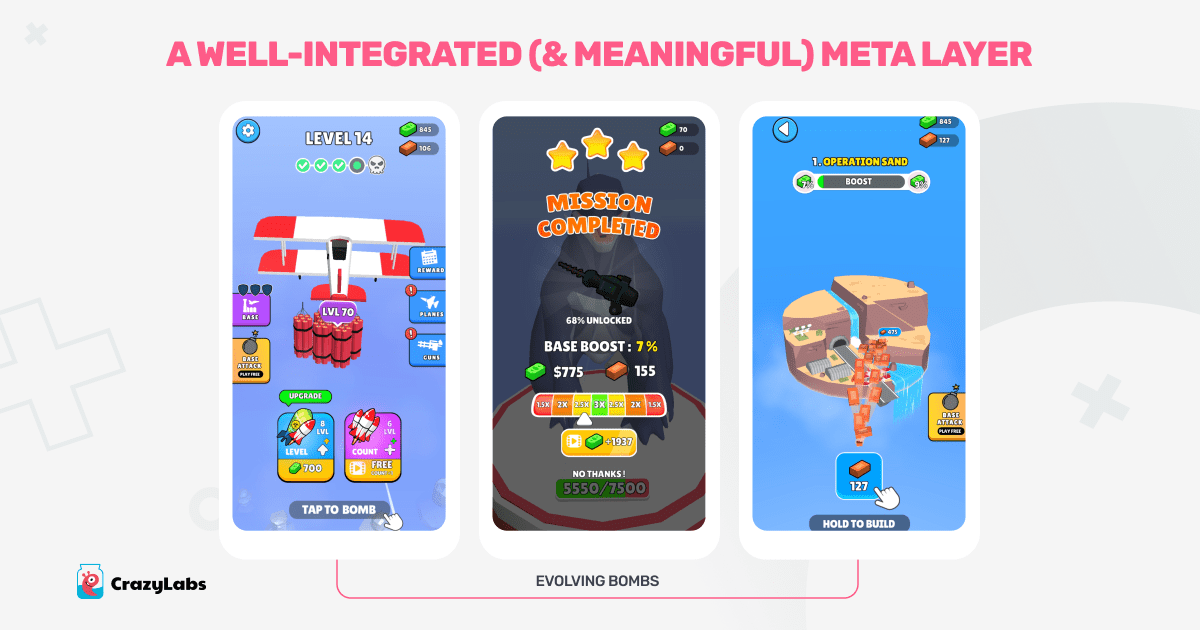
Don’t Forget to Collect User Feedback and Iterate
Your players are your best source of feedback. Conduct playtesting and gather insights from real players. Use analytics to identify pain points and areas for improvement. Continuously update and refine your game based on this feedback.

